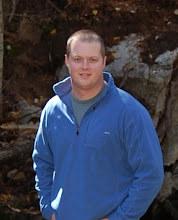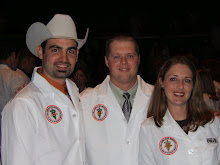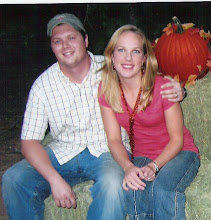I pull into the parking lot of the vet clinic at a quarter ‘til eight the next morning. The clinic consists of a plain brick building with a flat roof and a tin metal barn off to the side. The interior consists of a single exam room, a small surgery room that doubles as a second exam room when needed, a lab area, a small pharmacy, the receptionist office, a waiting room and a kennel. The barn houses a set of equine stocks and a hydraulic squeeze chute for working cattle. Behind the barn are a set of working pens and a small loafing shed for hospitalized livestock. When Dr. E built the clinic in 1980, he was a solo practitioner new to the area and designed the clinic for the needs of one veterinarian. The barn was an old Hostess bread warehouse. Dr. L joined the practice a few years later. Now that I have arrived on the scene, the clinic is definitely a small shell for three busy veterinarians. Point in fact, there are four cars waiting in the parking lot as I pull in to park.
I get out and unlock the front door and prepare to meet the rush. Two of the clients are dropping off animals for elective surgery, a dog to spay and a cat to neuter. Another has a puppy that had been vomiting the night before and the last is an ADR dog. ADR stands for “Ain’t Doing Right” and is a universally understood abbreviation in the veterinary industry originating with a pet owner’s description of their animal’s ailment - “She just ain’t doing right, doc.” Our more grammatically correct colleagues to the north sometimes say IDR, or isn’t doing right, but the meaning is the same.
I take the surgery animals back to the kennel to await their procedures as the rest of the staff arrive for work. Dr. L administers a pre-operative injection to the dog and prepares his surgical pack to perform the spay while Dr. E works up the vomiting puppy in the exam room. When he finishes, I take the ADR dog back to the exam room. The patient is a nine-year old Chihuahua with elderly owners that are complaining of a three-day history of anorexia and lethargy. I take a thorough history of the animal, discussing vaccination history, diet, and past medical problems. The dog is not on heartworm prevention, hasn’t been vaccinated in five years, and is fed a diet consisting primarily of table scraps. Off to a good start so far, I think to myself. My physical exam reveals severe periodontal disease with rotten, tartar covered teeth, a severe heart murmur, and congested lungs. I explain these findings to the owners, telling them that their dog is in congestive heart failure and that the dog’s dental condition could very well be contributing to the problem. I recommend testing for heartworms and performing chest x-rays and bloodwork to fully evaluate the degree of heart failure.
“How much is all that gonna cost,” the grizzled old man asks skeptically.
Doing a quick tally on the ticket, I reply, “Counting the physical exam that I just performed, the total would be around $300 for further diagnostics.”
The owner actually snorts as he exclaims, “Hell, it’s just a dog! Can’t you just give him a shot or something and fix him?”
“Unfortunately sir, they don’t make a shot that will just fix a failing heart,” I answer. “Especially when we don’t know for sure why it is failing in the first place.”
“Well, we just can’t spend that much money on a dog,” says the man’s wife. “I’ve got about $100 of my social security check left. What can we get done for that much?”
I consider my answer. “I tell you what. We’ll start him on a diuretic to help draw some of the fluid off of his lungs and an antibiotic to help treat the infection that he has in that mouth. Bring him back in a week and we will recheck his lungs and see where we want to go from there.”
As the couple leaves with their dog, Dr. E walks up and asks, “What was going on with that one?”
“Heart failure and periodontal disease for sure, probably has heartworms too, but they couldn’t afford much of a workup,” I say. “It sure is a lot different than vet school, Bob.”
“How do you mean?,” he asks.
“In school, we performed every diagnostic option at our disposal and worked up every single problem before we decided on a treatment option,” I say. “Here either they can’t afford or are unwilling to do all that and I end up having to do a lot of treatments based on guesswork.”
“Yeah, welcome to the real world, son,” Dr. E says with a wry grin. “These people don’t care if you know with absolute certainty what all is going on with their animals, they just want you to make them better. And most of the time if you can make an educated guess, you’ll get it right. Don’t worry, you’ll get used to it.”
Dr. E is in his mid fifties, a tall man with huge hands and feet. In his younger days he played baseball and basketball at Oklahoma State before attending vet school. He is loud and boisterous with a joke for every occasion. He and Dr. L are the ultimate odd couple. Dr. L is quiet and reserved, more methodical in his actions. Although they don’t see eye-to-eye on every issue, they have established a great practice and are well respected in the community. Both are excellent teachers and willing mentors.
The next patient that I see is an 8-month old boxer puppy that had been hit by a car early that morning. He is able to walk but is not putting any weight on his left rear leg, which is dangling unnaturally limp. Fearing the worst, I runs my hands over the leg, feeling the grating of bone against bone that signifies a fracture.
“I’m afraid the femur is broken, Mr. Edwards,” I tell the concerned owner, who is a teacher at the local high school. “I’ll need to take an x-ray of it to see how we can best repair the leg.”
“Do whatever you need to do,” the man replies. “The little guy is a member of the family, and we want to do whatever we can to make him better”
I pick the dog up and ask Cole to help me with the radiographs. We walk out the clinic back door to the barn, where the x-ray unit is located. The machine is a hulking monstrosity, six feet tall, unimaginably old and painted olive green. It looks like it came out of the engine room of a submarine. Due to it’s age and appearance I have started referring to it as Sergeant Surplus. It is a contrary and temperamental piece of equipment to work with.
“Cole, why don’t you put on the lead apron while I see if I can get this old soldier to report for duty,” I say as I flip the on switch and the unit sputters to life.
As he shrugs into the lead apron that will shield his body from the radiation of the x-rays, Cole asks, “How old do you think this piece of crap is anyway?”
“Ancient,” I reply. “This thing was probably radiographing shrapnel in dudes back in WWII. Dr. E must have gotten it from an Army surplus store or something. You should probably salute it in honor to its service to this great nation.”
Cole laughs, “That’s great. Did you learn how to work with this kind of stuff in school?”
“No, man,” I reply. “In school everything was digital, on computers. This is all OJT - On the Job Training.”
Cole holds the dog still while I click off a couple of films of the leg. I then take the films into the small dark room in the corner of the barn. The interior of the room is pitch black. The red light bulb that once provided illumination burned out sometime shortly after my birth and was never replaced. Interesting things lurk in the dark corners. Spiders, scorpions, Jimmy Hoffa’s body...that sort of thing. I hang the undeveloped films on metal hangers and suspend them within the developer chemicals of the dip tanks for processing. Five minutes later, I switch the films over to a different dip tank to fix the image to the film. Five minutes after that the films are developed and ready to be read. Holding the first film up to a light box, I study the fractured bone. Simple transverse fracture to the left femoral diaphysis. Should be easily repaired with an imtramedullary pin. Of course I’ve never seen that surgery, much less performed one. I take the films back into the clinic and seek out one of my colleagues for advice.
“Hey Bob,” I call, “can you take a look at these films with me?”
“Yeah, that should be a snap to fix,” he says after looking at the films. “Schedule it for in the morning and I’ll help you through it.”
I go over the radiographs with Mr. Edwards back in the exam room and explain the treatment plan. He agree to leave the dog with us for surgery the next day. I place a temporary splint over the broken leg to keep it stabilized and start the dog on pain meds and antibiotics before taking it back to the kennels.
At noon Dr. E, Cole, and I go to the Bullet Cafe for lunch. This small-town cafe is the social hub of the community, popular more for the conversation than the quality of their specials. The crowd at our table is quite the slice of local flavor: a few farmers, a couple of small town lawyers, a local factory owner, a city administrator, and a couple of veterinarians round out the dinner table most days. All are armchair philosophers and self-proclaimed experts on issues various and sundry. The table itself is one of those long tables where people sit down and eat and when they are finished somebody else takes their place. The faces change without so much as a lull in the conversation. It stays full all morning with coffee drinkers and then from 11 to 2 with the lunch crowd. They even hung a sign over it that reads, "World's Problems Solved Here." The lunch crowd is such a diverse mix of ages, backgrounds, and educations that you really get a lot of unique perspectives and quite the mix of topics. Today for instance, the discussions include the tribal customs of pacific islanders (tribes who wear gourds on their privates), suicide cults past and present, and Caribbean scuba diving hot spots. Eclectic and mundane topics alike get equal billing and all due attention.
After lunch I go out on a call to a farm a few miles away from the clinic to vaccinate three horses for rabies, west nile virus, and tetanus. While I am there, the owner asks if I will examine the teeth on one of the horses.
“That gelding keeps dropping grain when he eats,” says Mrs. Kelly, a matronly woman in her early fifties. “I was wondering if he needs his teeth floated.”
Taking a pen light from the chest pocket of my coveralls, I open the horses mouth and grasp his large pink tongue with one hand, pulling it gently to the side of his mouth as I shine the light to the back of his mouth with my other hand.
“Yes, ma’am, he has some pretty sharp points on those lower teeth,” I tell Mrs. Kelly. “Would you like for me to float his teeth while I’m here?”
“Oh could you?” she asks. “That would sure save me from having to haul him in to the clinic or having you come back out just for that.”
I get the dental floats out of my truck. These tools are basically long handles with small pieces of metal file welded to the ends that are used to grind the sharp points from the edges of horse’s teeth. These points are formed by the side-to-side motion that horses make when they chew and interfere with eating causing the animal to drop grain from it’s mouth. I sedate the gelding with an injection of Xylazine and wait a few minutes for it to relax the animal. Then I proceed to grind the points off of the teeth with the floats.
When I am finished, I reach in with my right hand to feel the now smooth edges of the teeth, checking my work. As I am withdrawing my hand I feel a sharp sensation of pain and hear distinct crunching sound. It turn out that this sound is the metacarpal bones in my right hand being crunched by the front teeth of the horse who decided it would be a good idea to bite down hard at just that moment. Choking back a curse, I manage to extract my mangled hand from the horses teeth. I tentatively flex a few times and discover that nothing is in fact broken, but it is beginning to swell and the back of the hand is rapidly turning a lovely shade of purple.
“Oh, he didn’t get you did he?” Mrs. Kelly asks.
“Yeah, just a bit,” I answer through gritted teeth.
“You ornery devil,” she says as she swats the horse playfully on the rump. “Why did you do that for?”
I write Mrs. Kelly out a bill, pack up my equipment, and head back to the clinic. Later that night I am sitting in front of my computer at home sending an email to my vet school classmates, typing a description of the day’s events titled Sergeant Surplus and the Purple Hand. After graduation we all dispersed to various jobs and internships across the country and we now communicate primarily through email, recounting our victories and disappointments to those most sympathetic to our plight. This connection serves to keep me sane and not feeling like an incompetent nincompoop. Most of the time, anyway. I sign off and pick up my copy of the veterinary surgery book to read up on the surgical techniques required to place an intramedullary pin to repair a femoral fracture. Nothing like a little light reading to unwind after a long day at work.







Colby, I LOVE your stories!! I had been waiting for an update! Keep them coming!
ReplyDeleteThanks for making me laugh today! Keep em coming!
ReplyDelete